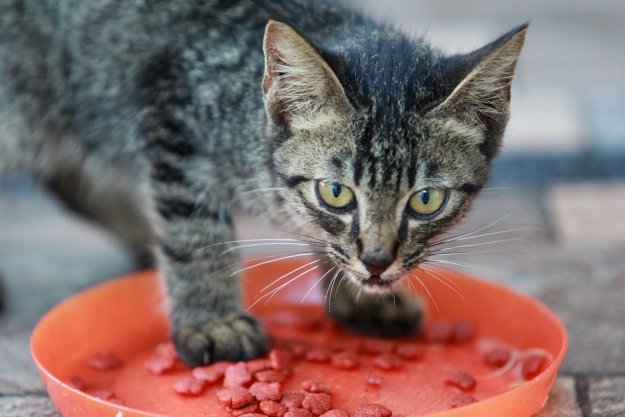Tasty cat treats can bring your kitty running, but treats can do more than just show your cat how much you love him. You can use treats to encourage your cat to perform certain behaviors, like standing up on his hind legs, jumping up into a cat bed, or even just holding still for a nail trim. When training a cat, you’ll need to feed him treats repeatedly to encourage that correct behavior, so it’s important to choose the best cat treats for training. Depending on how you’ll use the treats and your kitty’s health, you may want to pick treats that also benefit his well-being.
Best small treats
Small cat treats easily fit within your hand, and your cat can quickly eat them so you can get right back to training. Smaller treats also often contain fewer calories than larger treats do, an important factor when you might be feeding many treats in a shorter period. Smaller treats are often a better choice for kittens, too.
If you’re looking for quality small treats, Wellness Kittles are a great choice. These treats are available in six tasty flavors, including salmon and cranberries, duck and cranberries, and turkey and cranberries. Each treat delivers just two calories, and they’re made with real fruit, veggies, and meat. These grain-free crunchy treats are ideal for kittens and indoor cats.
Why we like it:
- Comes in six flavors
- Low-calorie
- Grain-free
Best healthy cat treats
You always want to be feeding your cat nutritious treats, but many formulas include fillers like corn and soy that really don’t give your kitty the nutrition he deserves. It’s particularly important to avoid these fillers when using treats as training aids, since your cat will probably eat lots of treats. Instead, consider a freeze-dried treat that’s made with only one ingredient, like chicken, fish, or turkey. With these types of treats, you’ll know just what you’re feeding your cat.
Life Essentials Freeze Dried Wild Alaskan Salmon Treats are a great option. Made solely of freeze-dried salmon, these treats have no fillers or preservatives. The cubes are crunchy and make an ideal daily snack or training treat. The salmon is low in fat, calories, and carbohydrates, so you can feed multiple treats without worrying about your cat gaining weight. Even better, the naturally occurring fish oils promote a shiny coat and have anti-inflammatory properties, too.
Why we like it:
- No fillers or preservatives
- Low in fat, calories, and carbs
- Fish oils aid against inflammation and promote a shiny coat
Best value
Cat treats can be expensive, especially if you’re stocking up for a multi-feline family. Looking for treats that balance value with quality is a savvy move, and many treat value packs offer excellent value. When buying treats in bulk, watch for options that offer multiple smaller packs of treats rather than one giant bag of treats. With multiple packs, you open them only when you’re ready to use one, keeping the treats fresh. A larger single pack of treats may go bad or stale before you use them all up.
The Temptations Classic Crunchy and Soft Treats Variety Pack is a winning choice because it includes four 3-ounce packs. Your cat will enjoy seafood medley, tasty chicken, creamy dairy, and tempting tuna flavors, so there’s plenty of variety to keep him intrigued. Each treat is just two calories, making them ideal for training.
Why we like it:
- Low-calorie
- Offers a variety of flavors
- Budget-friendly
Best for dental health
Training your cat can be good for his mental health, but the right treats can boost your cat’s dental health, too. Many treats are designed with crunchy exterior textures to help scrape food off your cat’s teeth. Feeding one of these treats offers multiple benefits while you train.
Feline Greenies Adult Dental Cat Treats are a fabulous example of this. These crunchy treats help clean teeth and reduce tartar buildup while also freshening your cat’s breath. They’re made with natural ingredients and are nutritionally balanced. These treats contain no artificial preservatives and contain less than two calories each.
Why we like it:
- Help clean teeth and freshen breath
- Made with natural ingredients
- Low-calorie
Choosing the best treats for training
Enticing treats that your cat truly loves can help make training easier. No matter which treats you choose, remember to follow the manufacturer’s feeding directions and don’t exceed the maximum recommended number of treats per day. It’s important to monitor your cat to make sure he’s still eating his regular food and isn’t just filling up on treats. His regular food gives him the nutrition he needs to stay healthy, so if his appetite seems to decline, reduce the number of treats you’re feeding him each day. Stay consistent and patient in your training, and you may be able to teach your cat a new trick or behavior.
Editors' Recommendations
- These useful tips can help you support your senior cat’s health
- Why do cats fight? They’re not just being jerks
- Why do cats roll in dirt? 10 reasons for their dust bath
- Is your cat obese? 5 ways to help them slim down
- Why do cats eat plastic (and when you should be concerned)?


